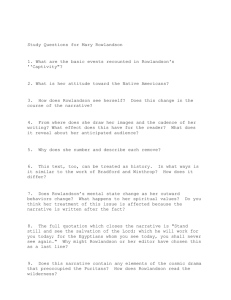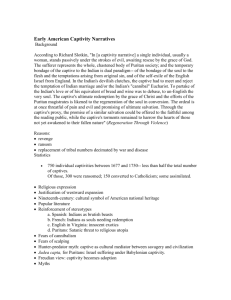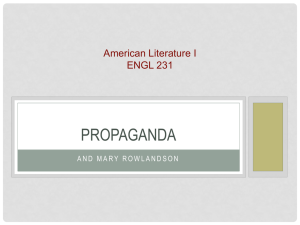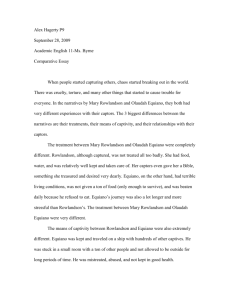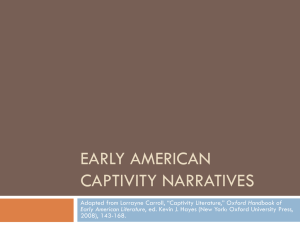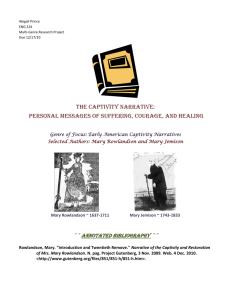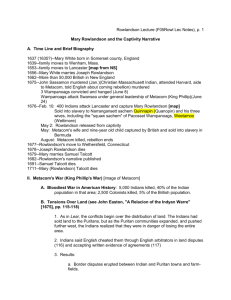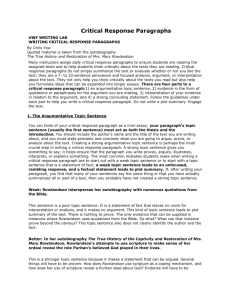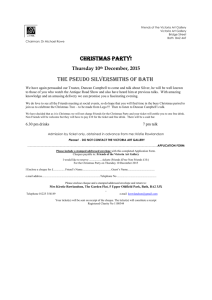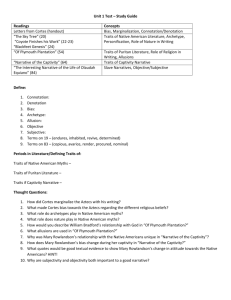Mary Rowlandson's Captivity Narrative: Student Guide
advertisement
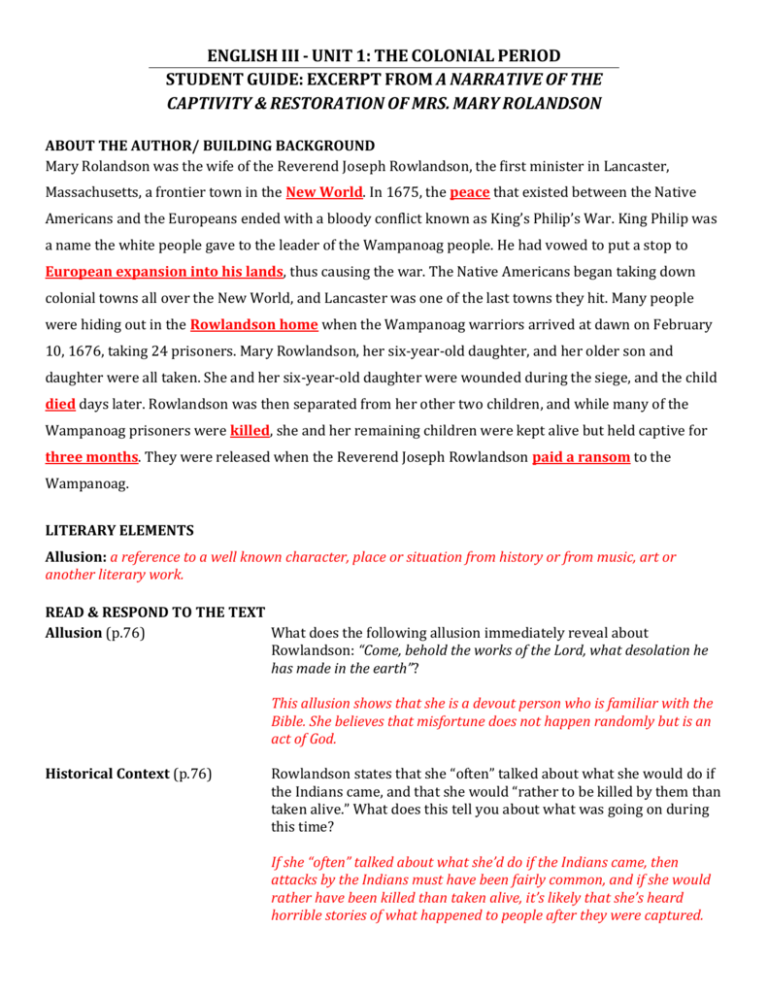
ENGLISH III - UNIT 1: THE COLONIAL PERIOD STUDENT GUIDE: EXCERPT FROM A NARRATIVE OF THE CAPTIVITY & RESTORATION OF MRS. MARY ROLANDSON ABOUT THE AUTHOR/ BUILDING BACKGROUND Mary Rolandson was the wife of the Reverend Joseph Rowlandson, the first minister in Lancaster, Massachusetts, a frontier town in the New World. In 1675, the peace that existed between the Native Americans and the Europeans ended with a bloody conflict known as King’s Philip’s War. King Philip was a name the white people gave to the leader of the Wampanoag people. He had vowed to put a stop to European expansion into his lands, thus causing the war. The Native Americans began taking down colonial towns all over the New World, and Lancaster was one of the last towns they hit. Many people were hiding out in the Rowlandson home when the Wampanoag warriors arrived at dawn on February 10, 1676, taking 24 prisoners. Mary Rowlandson, her six-year-old daughter, and her older son and daughter were all taken. She and her six-year-old daughter were wounded during the siege, and the child died days later. Rowlandson was then separated from her other two children, and while many of the Wampanoag prisoners were killed, she and her remaining children were kept alive but held captive for three months. They were released when the Reverend Joseph Rowlandson paid a ransom to the Wampanoag. LITERARY ELEMENTS Allusion: a reference to a well known character, place or situation from history or from music, art or another literary work. READ & RESPOND TO THE TEXT Allusion (p.76) What does the following allusion immediately reveal about Rowlandson: “Come, behold the works of the Lord, what desolation he has made in the earth”? This allusion shows that she is a devout person who is familiar with the Bible. She believes that misfortune does not happen randomly but is an act of God. Historical Context (p.76) Rowlandson states that she “often” talked about what she would do if the Indians came, and that she would “rather to be killed by them than taken alive.” What does this tell you about what was going on during this time? If she “often” talked about what she’d do if the Indians came, then attacks by the Indians must have been fairly common, and if she would rather have been killed than taken alive, it’s likely that she’s heard horrible stories of what happened to people after they were captured. Historical Context (p.77) Rowlandson says of her son that when she heard he was coming to the same place as her, she found him lying flat on the ground, but “he was not asleep, but at prayer; and lay so, that they might not observe what he was doing.” What does this illustrate to the reader as to the cultural differences between the Native Americans and the Europeans? Her son must be hiding his praying, which suggests that he would be punished by the Native Americans if they caught him. However, he is so devoted to God, like most of the early settlers, that he is willing to risk injury in order to pray. Historical Context (p.78) Why would Rowlandson consider telling the Native Americans to sell her for gunpowder, and why would she bother to take note that the Indians returned from Northhampton with horses? She realizes that the Native Americans need gunpowder to support the war effort, so they might be willing to sell her back to a white purchaser in exchange for some powder. She also realizes that the availability of horses might solve the practical difficulty of her getting away on foot. Characterization (p.78) Rowlandson periodically makes positive comments about her captors. Why do you think she includes these details in her narrative? She credits her captors with never doing her harm and also says that her Native American master showed her the way to her son. She may have included these details simply because she was an honest person or because she wanted to show the power and goodness of God. Big Idea (p.79) When her son was ill and she was unable to stay with him, she said that there was “no Christian friend near him to do any office of love for him, either for soul or body.” Why would it be important to her for her son to have a “Christian friend” near him? She wants her son to be cared for in the way she would care for him, by taking care of his wounds and also by reminding him to find strength in God. Allusion (p.79) When her son was sick and she didn’t know where her daughter was, she found comfort in her Bible, particularly in the following scripture: “Cast thy burden upon the Lord, and he shall sustain thee.” Why do these words help Rowlandson feel better about her children? The passage she quotes reaffirms the ideas behind her faith: that God will help her if she shares her troubles, and that she can find “great comfort” in her Bible. Big Idea (p.79) What does the following comment made by Rowlandson tell us about her: “That (eating a piece of bear) was savory to me that one would think was enough to turn the stomach of a brute creature.” It tells us that being in a rougher environment has led her to accept things that she would never have considered accepting before. READ & RESPOND TO THE TEXT What do Rowlandson’s captors do for her while she carries her wounded child? They put first her wounded child, then her, on a horse. What did Rowlandson say that she always intended to do if Native Americans attacked? Why do you think she changed her mind? She says that she would rather be killed than taken alive. She changes her mind because…ANSWERS WILL VARY. What experience does Rowlandson have with Metacom (King Philip)? What impression of him does this episode convey? Metacom pays her a shilling to sew a shirt for his child. This shows that he is humane. How does her attitude toward hardship change as a result of her captivity? She has learned to look beyond present, small troubles. ANALYZE & EVALUATE How does Rowlandson portray her captors? Is this portrayal fair? She resents being denied adequate food; she is also upset about the lack of care for her children. However, she does note the acts of kindness shown to her. She seems to give a balanced portrayal of the Native Americans. What qualities or behaviors help Rowlandson survive her ordeal? She is strong, possibly because of her religious faith. She thinks of her situation as God’s will. CONNECT TO THE BIG IDEA Captivity narratives such as this one were among the most popular literary genres in early America. What effect do think this type of literature might have had on the colonists’ attitudes and policies regarding Native Americans? Reading captivity narratives like this one may have deepened the settlers’ mistrust of the Native Americans and led to harsh policies. ANALYZING HISTORICAL CONTEXT Mary Rowlandson’s Indian-captivity narrative provides a glimpse of what it meant for an English settler to be captured and held against her will. It also provides important historical insights into the way the Wampanoags lived in the late 17th century and the way they treated their captives. Answer the following questions about the Wampanoag based on Rowlandson’s narrative. What did the Wampanoag’s diet consist of? Find all of the references of food in the selection, including the ways in which it was prepared. They ate horse, bear and bear grease, parched wheat, peas, groundnuts, deer, fawn and cake. What does the selection tell you about the burial practices of the Wampanoags? They buried their dead in the ground. What does the selection tell you about the dwellings in which the Wampanoags lived? They lived in wigwams, heated with fires; wigwams all looked alike; some were made of bark. What does the selection tell you about the geography of the area? Find all of the references to terrain. The terrain was a “vast and desolate wilderness,” a “thicket,” and apart from the “bay-towns.” What does the selection tell you about slavery among the Wampanoags? They bought and sold slaves, sometimes exchanging them for other goods, such as powder. What does the selection tell you about the way the Wampanogs treated their captives? They forced her to travel, even though her child was dying and she was wounded. Otherwise, they didn’t seem to treat her cruelly. They paid her for the work she did. They housed her in a wigwam. They spoke to her respectfully. What does Mary Rowlandson’s account tell you about her religious beliefs? Find all references in the selection that indicate her faith in God. There are four biblical citations, and there are multiple references to praying, to God and to the Lord.
